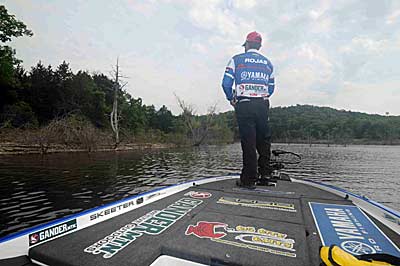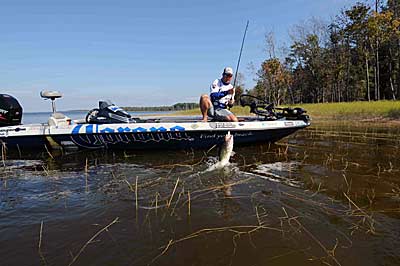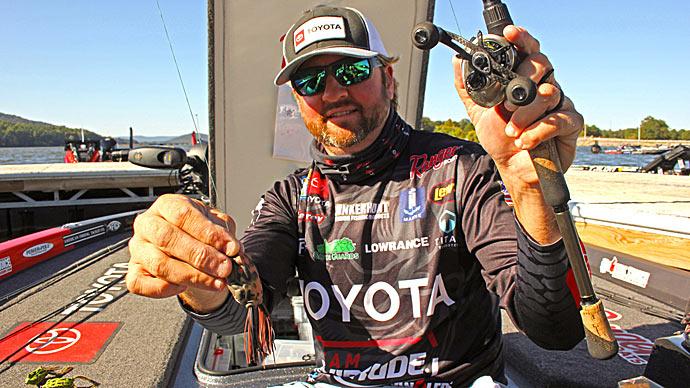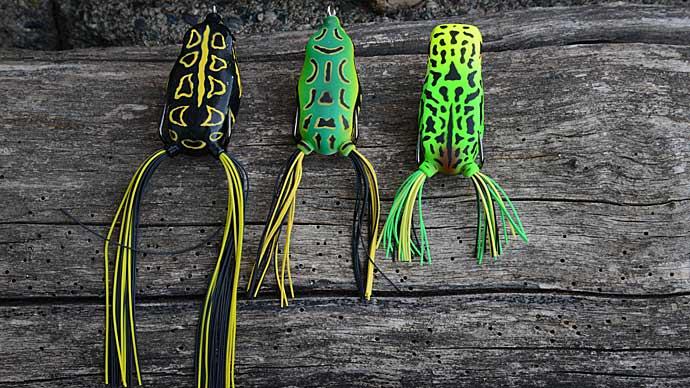
A master frogger, and a toad tinkerer, relish expanding their options with amphibian imitators.
The weedless features of plastic frogs and toads make these lures ideal for fishing over and through matted vegetation, but Major League Fishing (MLF) pros Dean Rojas and Brandon Coulter buck convention by throwing the baits in open water or sparse cover. The pros use both lures to give bass a different-looking topwater bait, and the toad allows them to cover water quickly in vast open areas.
When he wants to quickly cover a lot of water along vast flats with sporadic grass, Rojas relies on a one-two punch of a plastic toad and a Spro Bronzeye Frog. He throws the toad first to cover water and lets the fish "show themselves" to him. Then, if he gets short strikes or catches some bass on the toad, he switches to the frog. "Once you come back through again with the hollow belly frog, you can pick (the flat) apart," Rojas said. "You will know exactly where they are at."
The hollow belly frog allows Rojas to work an open area slowly and thoroughly once he has located bass with the toad. He can also stop the frog next to any small stickup or piece of vegetation and let it sit for a while to coax a bite.
The three styles of frogs Rojas fishes in open-water situations are the Spro Bronzeye Frog 65, Spro Bronzeye Popper, and Spro Bronzeye Spittin' Shad. Weather conditions dictate which frog Rojas tries for cruising bass. If the wind blows, he prefers the Popper or Spittin’ Shad because the lures create enough surface commotion to trigger strikes in the choppy water. "When it is calm, you want something that will put a wake out," Rojas said. So he relies on the Bronzeye Frog 65 to imitate the action of a school of shad waking on a calm surface.
The Arizona pro suggests retrieving the popping and spitting frogs with a combination of pops and pauses. “Let the fish tell you how they want it,” Rojas said. “That is the key. I always say experiment with it and try different things, and once you find the right combination of what they like, you have to duplicate it."
Rojas can employ a walk-the-dog retrieve in open water with the Bronzeye Frog because its pointed nose creates the same zigzag action as a topwater walker plug. Occasionally, the tournament veteran steadily reels in the Bronzeye Frog when fishing it around sparse weeds.
Water clarity determines the frog colors Rojas selects for his open-water tactics. He opts for frogs in light shades of brown, green, or shad patterns for clear water and black, white, or bright, bold hues for dirty water.
Rojas chooses a 7-foot medium-heavy action casting rod for open-water frogging combined with a 7.1:1 baitcast reel. Next, he throws his frogs on an 80-pound Sunline Braid.
Fishing in open water allows Rojas to open up the hooks on his frogs for a better hookset. “I get the (hook point) way away from the body because if the fish come up, I want to make sure I get them,” he said. "The hookup ratio goes up to almost 100 percent as long as they engulf the frog.”
Rojas also modifies his Bronzeye Frog 65 by trimming its legs down to about 2 1/2 inches in length. “The longer the legs are, the more it detracts the bait's action,” Rojas said. “I am always trying to make it dance, do flips and cartwheels and stuff, so I cut the legs because the shorter I cut the legs, the more action I get."
Toad-style baits such as the Zoom Horny Toad and Stanley Jigs Ribbit are the lures Brandon Coulter says he chooses "almost by default” in the fall when bass are spread out in transition and looking up at baitfish. “There is no other good way to catch them," he said. “It is almost like that time of year is so bad that 7 or 8 pounds seem to win tournaments.”
Buzzing the toad in open water produces more bass in the 3- to 4-pound class for Coulter during the fall. "It is an effective way to cover a lot of water and go for those seven or eight bites that get you up into that 14- or 15-pound range. "
“It is a commitment thing," Coulter said. "You are looking at an eight-fish day. It is not a 25-pound technique, but you are not trying to catch that in the fall. You are trying to catch 15 pounds, then.”

The open-water toad tactic starts producing for Coulter in late summer when wolf packs of bass cruise the shallows and chase bream. The technique continues to work for Coulter throughout the fall when shad move to the shallows and bass attack the baitfish balls on the surface.
A buzz bait also tricks shallow bass in late summer and throughout the fall, but Coulter believes bass become accustomed to seeing the buzzer and ignore it after a while. So he prefers buzzing the toad then to give bass a different look. The toad also allows him to run down a bank and work it effectively in sparse weeds and open water, whereas a buzz bait tends to hang up on the strands of the sparse weeds. Coulter also believes the toad draws more strikes from quality bass than a buzz bait does.
The Tennessee pro prefers rigging his toads on a 4/0 double-frog hook. "Toads didn't have a good hookup ratio, but the double hooks they now have increased the hookup on a Horny Toad tenfold," Coulter said.
The legs of the Horny Toad and Ribbit produce different bubbling sounds, so Coulter rotates the lures until he discovers which toad bass prefer. He also tinkers with colors rotating between dark, light, and neutral shades. The MLF pro says he throws a black toad about 70 percent of the time, but he will also try white in the same weather and water conditions. Colter's choice is a watermelon toad with an olive belly for tempting less aggressive bass in the open water.
Coulter favors retrieving his toad at a steady pace, just fast enough so the legs paddle on the surface. If he notices bass are short striking or just following the toad, he thinks bass are getting too good of a look at the bait. So he speeds up his retrieve to trigger more reaction strikes. Coulter buzzes his toad with a 7-foot, 3-inch rod matched with an 8.1:1 baitcast reel filled with a 40-pound braid. He prefers the lighter braid over the 65- to 70-pound braid because it is easier to cast the long distance he needs to cover more water with the toad.
BassResource may receive a portion of revenues if you make a purchase using a link above.




